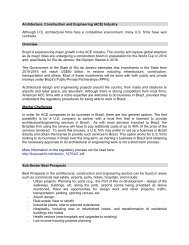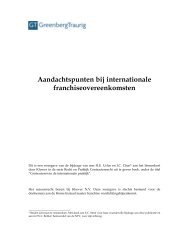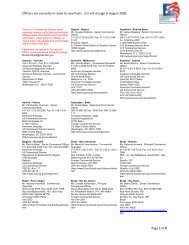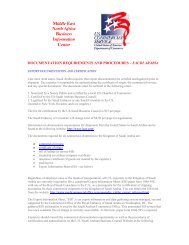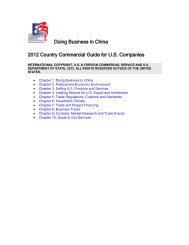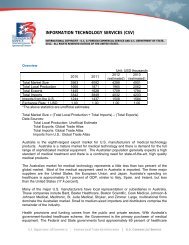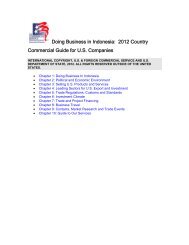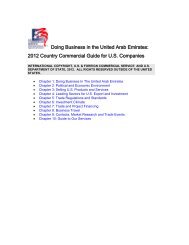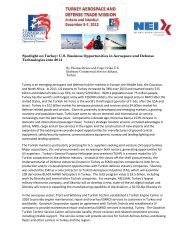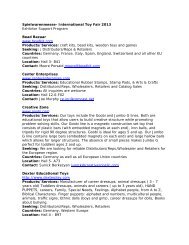CHINA: Franchising Industry - Export.gov
CHINA: Franchising Industry - Export.gov
CHINA: Franchising Industry - Export.gov
Create successful ePaper yourself
Turn your PDF publications into a flip-book with our unique Google optimized e-Paper software.
US Commercial Service – The JLJ Group<br />
China <strong>Franchising</strong> <strong>Industry</strong><br />
Page 8 of 23<br />
Sportswear. Experiencing double-digit growth since 2000 and expected to reach $6.2 billion by 2008.<br />
Popularity is fuelled by greater health awareness, changing lifestyles, and the Olympics. The segment is<br />
dominated by Nike, Adidas, Li-Ning, Anta, and Reebok, with a combined 40% market share in 2006.<br />
Competitive Landscape Return to Top<br />
Geographic distribution. Domestic, Hong Kong and foreign brands are found throughout Tier 1 and 2<br />
cities. The largest brands, such as Li-Ning and Esprit, are also present in Tier 3 cities. Products sold in<br />
Tier 1 cities are differentiated and targeted towards specific customer groups (e.g. young people into<br />
alternative fashion) while products in Tier 2 and 3 markets are still more generic. However, product<br />
differentiation in Tier 2 cities is expected to increase rapidly.<br />
Investment model. Domestic brands predominantly rely on the franchising model to expand. On the<br />
other hand, there is no dominant investment model for foreign brands – Etam has both direct-owned<br />
outlets and JVs, Vero Moda franchises in secondary markets, and Esprit uses franchising in primary<br />
and secondary markets. Among foreign franchises, the majority are European companies; major<br />
American fashion brands, like Gap 13 , are not yet in China.<br />
Table 3 – Key franchised chains in apparel sector<br />
Brand<br />
Foreign Franchisors<br />
Year of<br />
entry<br />
Total<br />
outlets<br />
Franchised<br />
outlets<br />
Location Comments<br />
Nike 1980 3174 2700+ National<br />
-<br />
-<br />
Targets young segment<br />
Prices similar to US and Europe<br />
Jeanswest 1993 1300 950+ National - Targets young segment, mid-end & premium<br />
Esprit 1992 300+ 270 National<br />
-<br />
-<br />
Targets the 25-40 age group.<br />
Plans to enlarge to 600 in the coming years<br />
Vero Moda<br />
2001<br />
700 14 - Targets young females, mid-range pricing<br />
Jack & Jones 1999 300 East China - Men’s fashion with focus on jeans, mid-range<br />
Only 1996 - For young women, mid-range pricing<br />
Hong Kong Franchisors<br />
Baleno (HK) 1996 3700 3327 National<br />
-<br />
-<br />
Casual wear for the average consumer<br />
Low prices<br />
Giordano (HK) 1992 728 644 East China - Casual wear, mid range<br />
Bossini (HK)<br />
Domestic Franchisors<br />
1993 449 150+ East & Mid - Casual wear, low-mid range<br />
- #1 domestic sports brand.<br />
Li-Ning 1990 4297 3860 National - Perceived as equal to Nike, but lower price<br />
- Entered the European market April 2007.<br />
Metersbonwe 1995 1800 1450 National<br />
-<br />
-<br />
Casual wear, targeted at young age group<br />
Mid-range<br />
Youngor 1979 1500 1200 National - Casual wear and costumes.<br />
SeptWolves 1990 1200 1000 East & Mid - Casual menswear.<br />
Baoxiniao 2001 600 551 National - High-quality suits.<br />
Note: Data for Mainland China, no. of outlets estimated; national presence refers to stores in almost all provincial capitals and other cities,<br />
East China refers to cities along the East coast, spreading from Guangdong in the south to Liaoning in the north; Mid China includes<br />
Sichuan, Chongqing, Wuhan, Shaanxi, etc;. Source: Company websites, phone interviews, news articles, and JLJ analysis.<br />
Key trends. As consumers become more sophisticated, the market structure is shifting from one with<br />
few varieties, high volumes, and long product life cycles to one with more variety, small volumes and<br />
short product life cycles. This is partly led by the successful entry of fast fashion brands like Zara and<br />
H&M in Tier 1 markets in the past 1-2 years. In coastal cities, strong brands, design, and quality are<br />
increasingly valued over low prices. Other segments which are increasingly popular include casual wear<br />
and apparel made of natural fibers, especially cotton.<br />
13<br />
Gap is currently present in Japan, Singapore, Indonesia, Malaysia and India. It only recently entered South Korea; the company has not<br />
announced specific plans for China.<br />
14<br />
Vero Moda, Jack & Jones and Only are owned by Bestseller; each store usually carries all three brands





